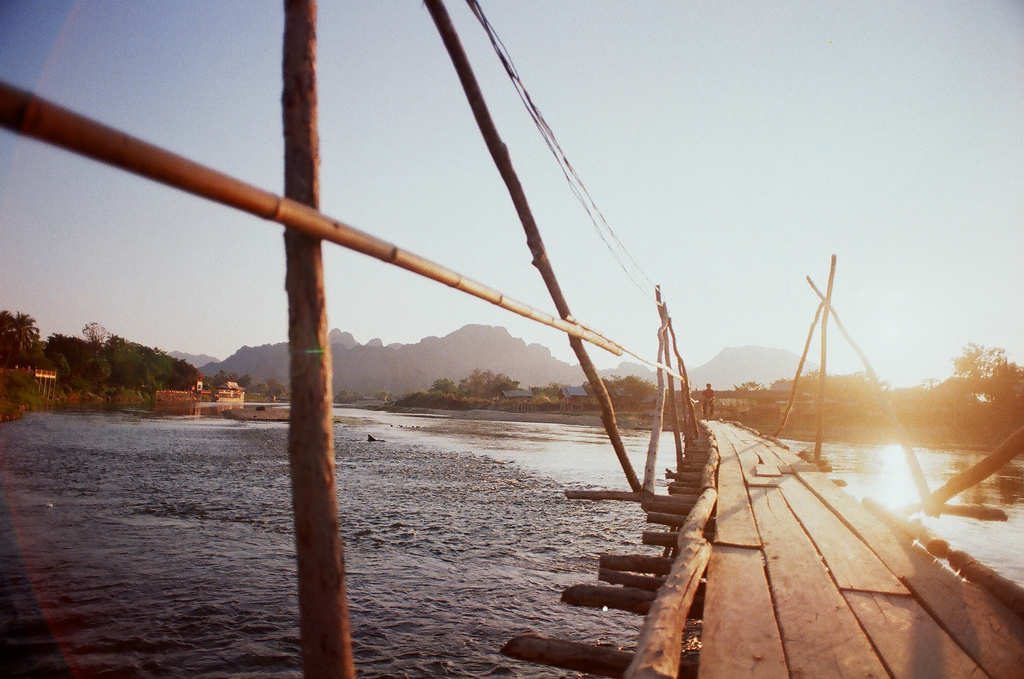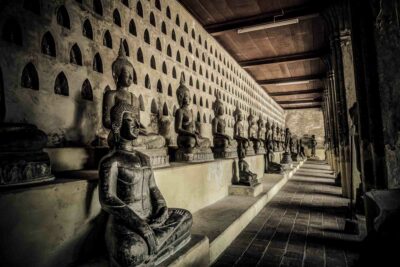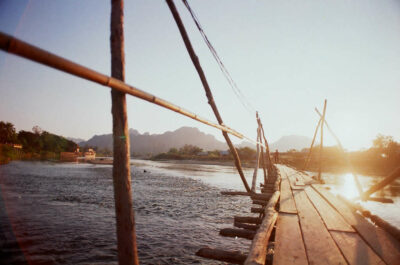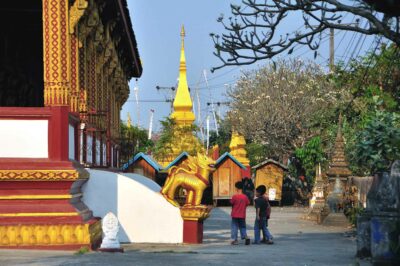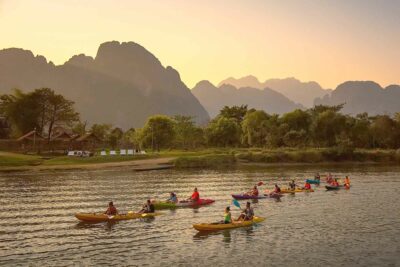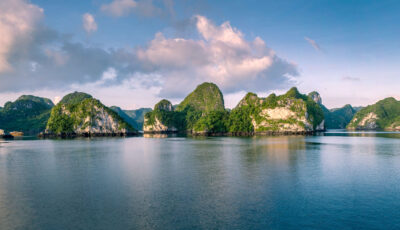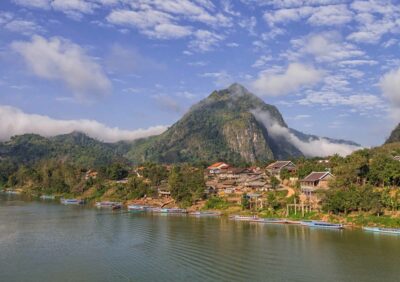Day 1: Vientiane / Arrival
Arrival at airport in Vientiane, we welcome you and transfer you to hotel. Check-in at hotel.
We start the tour by visiting the Patuxay monument, Laos’ version of the Arc de Triomphe. Continue out visit at Pha That Luang, the holiest site in Laos. We drive out of the city to visit the Buddha Park which contains numerous religious images. Back to the city.
Overnight in Vientiane. (B,L)
Day 2: Vientiane → Vang Vieng
Morning, we visit the serene Wat Sisaket, one of the most beautiful temples in the capital. Continue on to the nearby Wat Phra Keo where displays a collection of both Lao and Khmer works of art. Next, we visit COPE, an association working to help landmine victims. Lunch at a local restaurant.
Afternoon, we leave Vientiane and head to Vang Vieng. On the way, we visit Ban Houy Mo, a fishing village oh the way. Arrival in Vang Vieng, check-in at hotel.
Overnight in Vang Vieng. (B,L)
Day 3: Vang Vieng
In the morning, we will first stroll around the town to visit the local market to catch a gimpse of everyday life in a typical Lao rural area. We then visit Organic Farm Vang Vieng.
After that, we visit the cave of Tham Jang, which was used in the early 19th century in defense against the Chinese invaders. We also cross the river to Ban Huai Ngae, a very pleasant village where we can explore the different local lifestyles.
Afternoon, start cycling to Blue Lagoon (7Km from the town center), of which the waters are an aqua-blue, and are always cool. Visit the nearby Tham Phoukham Cave.
We go back to the city and board on a leisurely long-tail boat along the Nam Song River to admire the sunset.
Overnight in Vang Vieng. (B,L)
Day 4: Vang Vieng → Xieng Khouang
Morning, your leisure time in Vang Vieng. After early lunch, We bid farewell to Vang Vieng and drive to Xieng Khouang.
Arrival in Phonsavanh, the capital of Xieng Khouang province and check into your hotel.
Overnight in Xieng Khouang. (B,L)
Day 5: Xieng Khouang
Morning, we make a visit to the 3 "Plain of Jars" sites and also discover some local villages where you can observe local village life.
Afternoon, we drive to Muang Khoun, one that was not been destroyed by the American bombings during the secret war. Muang Khoun is home to unique sitting giant Buddha as well of some old pagodas that lies in ruins. Return to Phonsavan.
Overnight in Phonsavan. (B,L)
Day 6: Xieng Khouang → Luang Prabang
After breakfast, we have time today to explore the site and some nearby villages, populated by the Hmong hill tribe and Tai Dam people. Even though living a poor life, they possess a vibrant local culture and an interesting history.
We leave Xieng Khuang and drive to Luang Prabang. Arrive at Luang Prabang by late afternoon.
Overnight in Luang Prabang. (B,L)
Day 7: Luang Prabang
Morning, visit the Traditional Art and Ethnology Center to learn about Laos’ many ethnic cultures. Then visit Wat Xieng Thong, the royal city's most important temple.
Embark and cruise upstream on the Mekong River, visit the famous and mysterious Pak Ou Caves. Back to the city. Stop at the village of Ban Xanghai where they make the local rice wine. Lunch at a local restaurant.
After lunch, visit some major places: National Museum (Royal Palace), Wat Mai, UXO Visitor's Centre and Wat Visoun famous for its enormous stupa and its collection of old gilded Buddhas.
Finally, we reach the Mount Phousi to enjoy a panoramic sunset view of Luang Prabang.
- Overnight in Luang Prabang.
- B,L
Day 8: Luang Prabang → Siem Reap
Morning, we drive to Living Land Lao Organic Farm at Phoung Van village. Learn and experience the real activities and life of a Lao farmer.
Afternoon, we drive to the beautiful Kuang Si Waterfall where you can splash around in the pools or walk along the forest paths. Before coming back to Luang Prabang, we still have time to visit Kuang Si Falls Butterflies Park, newly opened January 2014, it is now one of the must-see spots in Luang Prabang. We return to the city.
Spend your leisure time in the city until we transfer you to airport for flight to Siem Reap.
Overnight in Siem Reap. (B,L)
Day 9: Siem Reap
In the morning, you will visit Angkor Thom, the ancient capital of the Khmer empire. Then, you will continue your visit to Ta Prohm, a stunning temple complex with trees and vegetation growing around and through its structures. Lunch will be at a local restaurant.
In the afternoon, you will visit Angkor Wat, the most famous of all the temples in Angkor. Angkor Wat is a massive temple complex and is one of the largest religious monuments in the world.
In the evening, enjoy buffet dinner and watch Khmer Traditional Dance Show at a local restaurant.
- Overnight in Siem Reap.
- B,L,D
Day 10: Siem Reap
We depart the city at 8:00am and head to Koh Ker, which takes about 1.5 hours. Upon arrival, we will venture into the deserted ruins and surrounding forest and explore the Koh Ker temple complex, the former capital of the Angkorian empire during the years AD 928 to AD 944.
10.30am, we drive back to Siem Reap. On the way back, we stop at two famous temples: Prasat Neang Khmaw & Prasat Pram. Lunch at a local restaurant near Beng Mealea temple.
1.30pm, we visit Beng Mealea temple. Enjoy a short walk through the dense jungle and discover the wonders of an overgrown temple, Beng Mealea, which lay undiscovered for centuries. We proceed to the last one that we visit today, Banteay Srey, the “gem” of the Angkor area.
- Overnight in Siem Reap.
- B,L
Day 11: Siem Reap / Departure
Morning, breakfast at hotel. Rest of the day is your leisure time to explore Siem Reap on your own until we transfer you to airport for your departure flight. (B)End of the tour!
Details
<span class="duration">11 days.</span> Best of Laos and Cambodia
Day 1: Vientiane / Arrival
Arrival at airport in Vientiane, we welcome you and transfer you to hotel. Check-in at hotel.
We start the tour by visiting at the Patuxay monument, Laos’ version of the Arc de Triomphe, where you can climb the stairs to the roof for sweeping panoramic views of the city. Take some photos before we continue out visit at Pha That Luang, the holiest site in Laos. Constructed by King Setthethirat in the 16th century, the temple is resplendent as the sun is shines upon its towering golden spire.
We drive out of the city to visit the Buddha Park. Buddha Park, also known as Xieng Khuan, is a sculpture park located 25 km southeast from Vientiane, Laos, in a meadow by the Mekong River. Although it is not a temple, the park may be referred to as Wat Xieng Khuan, since it contains numerous religious images. The name Xieng Khuan means Spirit City.
Overnight in Vientiane. (B,L)
Day 2: Vientiane → Vang Vieng
After breakfast, enjoy a guided tour to discover the hidden charms of Vientiane. Vientiane is one of the quietest capital cities in the world, far away from the bustle and hustle of other Asian capitals.
We begin our tour by visiting the serene Wat Sisaket, the only temple left intact after the Siamese (Thai) invasion in 1828. It is one of the most beautiful temples in the capital, and its breezy teak covered hallways are filled with thousands of miniature Buddha statues.
Continue on to the nearby Wat Phra Keo. Used as a religious museum, Wat Phra Keo displays a collection of both Lao and Khmer works of art. Also nearby, is the Presidential Palace. Although you are not allowed to visit inside, it is a good glimpse in to the town’s colonial past as this building formerly served as the French governor’s palace.
Next, we visit COPE, an association working to help landmine victims. A visit to the center provides in-depth information about the history of the American/Vietnam war and the lasting impact of unexploded ordinances (UXO) in the area and the efforts underway to clear them.
Afternoon, we leave Vientiane and head to Vang Vieng. Along the way, we visit Ban Houy Mo (if we have enought time), a fishing village oh the way. Arrival in Vang Vieng, check-in at hotel.
Overnight in Vang Vieng. (B,L)
Day 3: Vang Vieng
In the morning, we will first stroll around the town to visit the local market to catch a gimpse of everyday life in a typical Lao rural area. We then visit Organic Farm Vang Vieng.
After that, we visit the cave of Tham Jang, which was used in the early 19th century in defense against the Chinese invaders. We also cross the river to Ban Huai Ngae, a very pleasant village where we can explore the different local lifestyles.
Early morning, start cycling to Blue Lagoon (7Km from the town center), of which the waters are an aqua-blue, and are always cool. We will also visit the nearby Tham Phoukham Cave, which contains a reclining Buddha statue as well the requisite formations normally found in caves.
We go back to the city and board on a leisurely long-tail boat along the Nam Song River to admire the sunset.
Overnight in Vang Vieng. (B,L)
Day 4: Vang Vieng → Xieng Khouang
Morning, your leisure time in Vang Vieng. After early lunch, we leave Vang Vieng and head to Xieng Khouang.
It's time to bid farewell to Vang Vieng and drive to Xieng Khouang.
Arrival in Phonsavanh, the capital of Xieng Khouang province and check into your hotel.
Overnight in Xieng Khouang. (B,L)
Day 5: Xieng Khouang
In the morning, we make a visit to the 3 "Plain of Jars" sites and also discover some local villages where you can observe local village life. Site 1, close to the town is settled at Thong Hai Hin and is the biggest site. Site 2 is at Hai Hin on Phou Salator, “Phou” in Lao means “Mountain”. End your tour at site 3 in Hai Hin Lat Khai. Site 3 is the most impressive with over 150 jars. Close to this site, you will visit Ban Xiengdi where there is a small monastery with Buddha images. On the way back, you will pass areas that were important battlefields during the American secret war. You can still see bomb craters from that time today.
Attention: The Plain of Jars has been heavily bombed during the war and you have to respect all the signs and stay along the defined trails due to bombs, UXO and landmines.
The Plain of Jars is a huge archaeological complex littered with mysterious 2000 years old stone jars sized from 70cm up to 3 or 4 meters. Their true origin remains a mystery. It seems that they were carved into boulders. Several researches lead by the French archaeologist Madeleine Colani in the 30’s suggested that they could be old graves, but to this day they remain an enigma.
In the afternoon, enjoy a half day trip to Muang Khoun. Muang Khoun one place in the old provincial capital that was not been destroyed by the American bombings during the secret war. Muang Khoun is home to unique sitting giant Buddha as well of some old pagodas that lies in ruins. The foundation and columns of Wat Pia Wat are still standing and close to this site, there is also an old 30m stupa constructed in the Lan Xang/Lanna period.
Return to Phonsavan.
Overnight in Phonsavan. (B,L)
Day 6: Xieng Khouang → Luang Prabang
After breakfast, we have time today to explore the site and some nearby villages, populated by the Hmong hill tribe and Tai Dam people. Even though living a poor life, they possess a vibrant local culture and an interesting history.
We leave Xieng Khuang and drive to Luang Prabang. Arrive at Luang Prabang by late afternoon.
Overnight in Luang Prabang. (B,L)
Day 7: Luang Prabang
In the morning, we visit the Traditional Art and Ethnology Center to learn about Laos’ many ethnic cultures. Our next place to visit is Wat Xieng Thong. Built by King Setthathirath (1559), Wat Xieng Thong is the royal city's most important temple. Its multiple roofs sweep low to the ground and there's a stunning 'tree of life' mosaic set on its western exterior wall.
We then embark on the a leisure cruise upstream on the Mekong River, which also gives us a breathtaking view of the tranquil countryside, before reaching the mysterious Pak Ou Caves, two linked caves crammed with thousands of gold lacquered Buddha statues of various shapes and sizes left by pilgrims. Along the way, we stop at the village of Ban Xanghai, where they make the local rice wine. Have lunch at a local restaurant.
After lunch, we visit the fascinating National Museum (Royal Palace). The National Museum in Luang Prabang, Laos, was built in 1904 during the French colonial era for King Sisavang Vong and his family. The site for the palace was chosen so that official visitors to Luang Prabang could disembark from their river voyages directly below the palace and be received there.
We continue our visit at Wat Mai Suwannaphumaham (often simply Wat Mai or Wat May) is a Buddhist temple or wat in Luang Prabang, Laos. It is the largest and most richly decorated of the temples in Luang Prabang. Built in the 18th century, it is near the Royal Palace Museum. An emerald Buddha statue sits inside the red-gold interior.
We'll visit either the UXO Visitor's Centre (UXO Museum is closed on Saturday & Sunday, we can visit peruse local crafts at Ock Pop Tok alternatively).
Next, we’ll explore the 16th century Wat Visoun, known for its enormous stupa and its collection of old gilded Buddhas.
We end the day’s tour on top of Mount Phousi in the city centre. Enjoy a sunset view of the gilded stupa as well as a panoramic view of the city and surrounding landscape.
Overnight in Luang Prabang. (B,L)
Day 8: Luang Prabang → Siem Reap
After breakfast, we drive to Living Land Lao Organic Farm at Phoung Van village. Upon arrival, your guide and the representative of the farm will brief about the historical and activity of the farm. After that it is your chance to experience the real activities and life of a Lao farmer. You will really have your hand on all the activities including ploughing, seeding, manuring, until reaping the harvest. For sure you will know how hard to grow the rice. Last but not least, we will have a short visit to the vegetable garden and the guide will teach you how to realize many type of vegetable. It is really exciting to learn all those things for the first time.
Afternoon, we drive to the beautiful Kuang Si Waterfall where you can splash around in the pools or walk along the forest paths. Before coming back to Luang Prabang, we still have time to visit Kuang Si Falls Butterflies Park, newly opened January 2014, it is now one of the must-see spots in Luang Prabang. We return to the city.
Spend your leisure time in the city until we transfer you to airport for flight to Siem Reap.
Overnight in Siem Reap. (B,L)
Day 9: Siem Reap
The first part of the day will be spent exploring some of the most iconic temple complexes in Angkor, Cambodia. The morning begins with a visit to Angkor Thom, the ancient capital of the Khmer Empire. Here, you can explore some of the most significant structures, including the Bayon Temple, the Baphuon, the Phimeanakas, the Royal Enclosure, the Elephants Terrace and the Terrace of the Leper King.
Afterward, you will continue your visit to Ta Prohm, a temple complex that is famous for its unique architecture and the way that trees and vegetation have grown around and through its structures. This temple complex provides a stunning visual experience and is one of the most popular destinations for visitors to Angkor.
Lunch will be served at a local restaurant, where you can enjoy some of the local cuisine.
In the afternoon, you will visit Angkor Wat, the most famous of all the temples in Angkor. This massive temple complex is one of the largest religious monuments in the world and is famous for its intricate architecture and stunning beauty. Here, you can explore the central temple, the outer walls, and the surrounding moat.
In the evening, you will enjoy a buffet dinner and watch a Khmer Traditional Dance Show at a local restaurant. This is an excellent opportunity to experience some of the local culture and enjoy some traditional entertainment while dining on local cuisine.
Overnight at hotel in Siem Reap.
Day 10: Siem Reap
At 8.00am, we drive out of the city to go to Koh Ker. Abandoned to the forests of the north, Koh Ker, capital of the Angkorian empire from AD 928 to AD 944, is 127km northeast of Siem Reap. It takes about 1.5 hour to reach Koh Ker.
Koh Ker is a 10th-century temple complex in the north Cambodian jungle. A former capital of the Khmer Empire, the site is now remote and heavily forested. The main structure, Koh Ker Temple, is a stepped 7-tiered pyramid. The large rectangular tank, Rahal Baray, supplied water to the complex. The Prasat Krahom, meaning "red temple," is known for its sandstone carvings, while Prasat Pram is covered in strangler figs.
9.30am, We start at Prasat Krahom where impressive stone carvings grace lintels, doorposts and slender window columns. The principal monument is Mayan-looking Prasat Thom, a 55m-wide, 40m-high sandstone-faced pyramid whose seven tiers offer spectacular views across the forest.
10.30am, we drive back to Siem Reap. On the way back, we stop at two famous temples: Prasat Neang Khmaw & Prasat Pram. We proceed our way back and stop at a local restaurant near Beng Mealea temple. Enjoy your lunch.
1.30pm, we visit Beng Mealea temple. Enjoy a short walk through the dense jungle and discover the wonders of an overgrown temple, Beng Mealea, which lay undiscovered for centuries.
A spectacular sight to behold, Beng Mealea, located about 55km northeast of Siem Reap, is one of the most mysterious temples at Angkor, as nature has well and truly run riot. Exploring this titanic of temples, built to the same floor plan as Angkor Wat, is the ultimate Indiana Jones experience. Built in the 12th century under Suryavarman II, Beng Mealea is enclosed by a massive moat measuring 1.2km by 900m.
3.30pm, we leave Beng Mealea and drive to the last one that we visit today, Banteay Srey.
4.30pm, Arrival at the temple. You now have chance to see the “gem” of the Angkor area. The so-called “Citadel of the Women” displays some of the finest examples of classical Khmer art.
Considered by many to be the jewel in the crown of Angkorian art, Banteay Srei is cut from stone of a pinkish hue and includes some of the finest stone carving anywhere on Earth. Begun in AD 967, it is one of the smallest sites at Angkor, but what it lacks in size it makes up for in stature. The art gallery of Angkor, Banteay Srei, a Hindu temple dedicated to Shiva, is wonderfully well preserved and many of its carvings are three-dimensional.
Overnight in Siem Reap. (B,L)
Day 11: Siem Reap / Departure
Morning, enjoy breakfast at hotel. Visit Angkor National Museum at 7.30am. Angkor National Museum is an archaeological museum dedicated to the collection, preservation and presentation of Angkorian artifacts, also to provides information and education about art and culture of Khmer civilization, with collections mainly dated from Khmer Empire's Angkor period circa 9th to 14th-century. Most of the artifacts are discovered in and around the Angkor archaeological sites nearby. The museum is located in Vithei Charles de Gaulle No. 968, Siem Reap, Cambodia, on the way between downtown Siem Reap to northern road leading to Angkor ancient city. After that, take a boat trip for sight-seeing on Tonle Sap Lake, the Great Lake of Cambodia. It is one of the largest lakes in Asia. Here, enjoy a brief cruise past floating villages complete with schools, restaurants, and hospitals. Leave the lake and head to downtown to visit Artisan's D'angkor, the caving art school. Continue your visit to Wat Thmei. Wat Thmei near Charles de Gaulle Boulevard in Siem Reap, Cambodia where you will find a small memorial stupa which contains the skulls and bones of victims killed during the regime of the Khmer Rouge during 1975 – 1979. Transfer to Siem Reap airport for your departure flight.Inclusion
INCLUSION
 All flights in the tour.
All flights in the tour.
 Hotel & accommodation
Hotel & accommodation
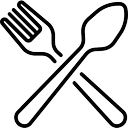 Meals (B,L,D = Breakfast, Lunch, Dinner).
Meals (B,L,D = Breakfast, Lunch, Dinner).
 Transfer vehicle.
Transfer vehicle.
 English speaking guide.
English speaking guide.
 Entrance and sightseeing tickets.
Entrance and sightseeing tickets.
EXCLUSION
 Drinks.
Drinks.
 Tips.
Tips.
 Personal expenses.
Personal expenses.
 International flights.
International flights.
SINGLE SUPPLEMENT:
May be applied with solo traveler.

